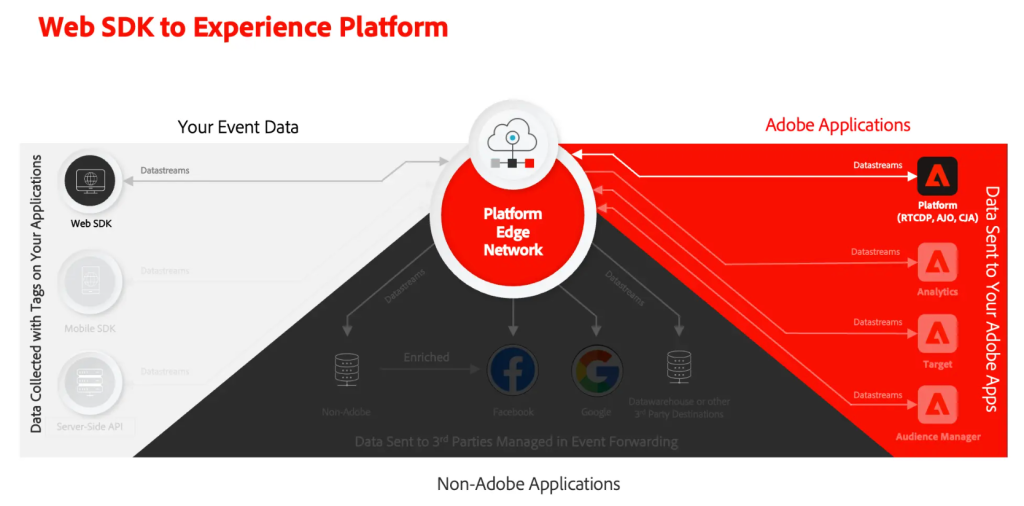In the ever-evolving digital analytics landscape, staying ahead of the curve is crucial for businesses aiming to harness actionable insights from their data. As organizations increasingly seek more robust, flexible, and future-proof solutions, transitioning from the older Adobe AppMeasurement method to the Web SDK emerges as pivotal. But how do you navigate this shift seamlessly without disrupting your analytics ecosystem?
Welcome to our comprehensive guide on transitioning from Adobe AppMeasurement to Web SDK. In this post, we'll delve into the key benefits of upgrading to the Web SDK, outline the step-by-step process for a smooth transition, and share expert tips to maximize the potential of your analytics strategy. Whether you're a seasoned data professional or a digital marketer looking to elevate your analytics game, this guide will equip you with the knowledge and tools to make the switch confidently and precisely. Let's embark on this journey towards more sophisticated and insightful data collection!
Overview of the Migration Process from AppMeasurement to the Web SDK
Migrating from Adobe AppMeasurement to the Adobe Experience Platform Web SDK is a significant step towards enhancing your analytics capabilities. The Web SDK offers a unified, streamlined approach to data collection, which can lead to more accurate insights and improved performance. Here’s a detailed overview of the migration process, complete with actionable advice and specific examples.
Step 1: Assessment and Planning
Begin by conducting a thorough assessment of your current AppMeasurement setup. Identify all the variables, events, and eVars you are currently tracking. Create a comprehensive migration plan that outlines how to map these elements to the Web SDK's data elements and XDM (Experience Data Model) schema.
Example: If you track page views and click events in AppMeasurement, map these to the corresponding XDM objects in the Web SDK. For instance, a page view in AppMeasurement might be mapped to an `eventType` of `"pageView"` in the XDM schema.
Step 2: Setting Up the Web SDK
Install and configure the Web SDK in your environment. This involves updating your tag management system, such as Adobe Tags (formally Launch), to include the Web SDK extension. Configure the SDK settings to connect to your Adobe Experience Platform, ensuring data flows correctly.
Actionable Advice: Utilize Adobe Tags to manage your tags efficiently. Create rules that fire the Web SDK on specific user interactions, replicating the behavior you previously had with AppMeasurement.
Step 3: Data Layer Implementation
Define your data layer based on the XDM schema. Ensure that your data layer is comprehensive and aligns with the specific requirements of the Web SDK. This will involve updating your website’s code to capture relevant events, user interactions, and page-level data. The data layer must follow a structured format that mirrors the XDM schema to ensure smooth data ingestion and compatibility with downstream tools like Adobe Analytics, Audience Manager, and other Experience Cloud solutions. Testing and validation must also be conducted to ensure that the data collected from the data layer matches the defined schema and is correctly sent through the Web SDK to your desired endpoints.
Actionable Advice: To ensure a smooth implementation, collaborate closely with your development team to integrate the data layer correctly and follow best practices for scalability. Regularly validate the data using tools like Adobe Experience Platform Debugger to confirm that the correct information is being captured and sent.
Advantages of Migrating from AppMeasurement to the Web SDK
Migrating from Adobe AppMeasurement to the Web SDK offers a wealth of advantages that can significantly enhance your analytics capabilities and streamline data management. Here, we delve into the key benefits and provide actionable insights to make your transition as seamless and impactful as possible.
Unified Tag Management
One of the Web SDK's most compelling advantages is its ability to consolidate multiple Adobe solutions under a single implementation. Previously, the older implementation methods typically required separate tags for different Adobe products (like Analytics, Target, and Audience Manager), the Web SDK serves as a unified platform. This simplifies tag management and reduces the likelihood of tag conflicts and data discrepancies.
Actionable Advice: Leverage Adobe Experience Platform Tags to manage your Web SDK tags. This tool simplifies deployment and ensures all your Adobe solutions work harmoniously, reducing the time and effort required to maintain multiple tags.
Improved Performance and Page Load Speed
The consolidated scripts of the Web SDK are optimized for performance, contributing to faster page load times. This can significantly enhance the user experience and SEO performance. On the other hand, multiple AppMeasurement tags can increase the complexity of your website’s code and lead to slower load times due to redundant or excessive script calls. This impacts the user experience negatively and can hurt SEO rankings by delaying page rendering and increasing bounce rates. Consolidating data collection through the Web SDK reduces the overall footprint and streamlines data transmission, making it a more efficient and future-proof solution.
Challenges and Potential Drawbacks of This Migration Approach
While transitioning from Adobe AppMeasurement to Adobe Web SDK can offer enhanced analytics capabilities, the migration has challenges and potential drawbacks. Understanding these obstacles is crucial for a seamless transition.
Technical Complexity
One of the most significant challenges is the technical complexity involved. Adobe Web SDK fundamentally differs from AppMeasurement, necessitating a deep understanding of the new framework. For instance, Web SDK uses a unified edge network to collect data, which requires reconfiguring data collection endpoints and possibly rewriting custom code. This can be daunting for teams not well-versed in the new architecture.
Actionable Advice: Invest in comprehensive training for your development and analytics teams. Adobe offers extensive documentation and support, which can help ease the transition. Additionally, consider hiring a consultant experienced in Web SDK to guide the process (Shameless Plug Alert: ACG Consultants can help support your transition to Web SDK).
Data Mapping and Consistency
Another significant hurdle is ensuring data consistency during the migration. The data layer and tracking calls must be meticulously mapped from AppMeasurement to Web SDK to prevent data loss or inconsistencies. For instance, if you’re tracking user interactions, you must ensure that the same variables and events are captured accurately in the new system.
Downtime and Performance Issues
The migration process can lead to temporary downtime or performance issues, especially if not managed carefully. This can impact real-time data collection and reporting, potentially disrupting business operations.
Steps to Implement the Web SDK: Datastream Creation, Library Installation, Configuration, and Validation
Transitioning from Adobe AppMeasurement to the Web SDK for enhanced analytics involves several key steps: creating a datastream, installing the library, configuring the SDK, and validating the implementation. Below, we delve into each of these steps with specific examples and actionable advice.
1. Datastream Creation
The first step in implementing the Web SDK is to create a datastream in Adobe Experience Platform. This datastream acts as a conduit for data flowing from your websites and applications to Adobe's analytics services.
Example:
- Navigate to Adobe Experience Platform.
- Go to the "Datastreams" section and click "Create Datastream".
- Select the appropriate data source and destination.
- Configure the datastream with the necessary details such as name, description, and data retention policies.
Actionable Advice:
Ensure that the datastream aligns with your data governance policies and compliance requirements. Properly configuring data retention and privacy settings at this stage can save significant effort later.
2. Library Installation
Next, install the Adobe Web SDK library. This SDK consolidates various functionalities into a single, streamlined library, simplifying the integration process.
Actionable Advice:
Regularly update the SDK to leverage the latest features and security patches.
How this Migration Sets the Stage for Future Use of Customer Journey Analytics
Transitioning from Adobe AppMeasurement to Web SDK is more than an upgrade; it’s a strategic move that can significantly enhance your future use of Customer Journey Analytics (CJA). Let’s explore how this migration sets the stage for more robust, insightful customer journey mapping.
Unified Data Collection
The Adobe Web SDK consolidates data from various sources into a unified format, making it easier to integrate with Adobe Experience Platform (AEP). By doing so, it eliminates data silos that can obscure the complete view of the customer journey. For instance, consider a retail business tracking customer interactions across its website, mobile app, and in-store transactions. All these touchpoints can be cohesively tracked and analyzed using CJA, providing a comprehensive view of customer behavior.
Real-Time Data Streaming
One of the paramount advantages of Web SDK is its capability for real-time data streaming. This immediacy is crucial for Customer Journey Analytics, enabling businesses to react promptly to customer actions. For example, if a customer abandons their shopping cart, real-time data can trigger an immediate retargeting campaign, increasing the likelihood of conversion. According to a study by Forrester, real-time analytics can boost marketing efficiency by up to 30%.

Source: Adobe Experience League
Enhanced Customer Profiles
Web SDK’s integration with Adobe Experience Platform allows for enriched customer profiles. By aggregating data from multiple sources, businesses can build detailed customer personas that reflect preferences, behaviors, and intents. This enriched data is gold for Customer Journey Analytics, enabling more precise segmentation and personalized marketing strategies. For example, an airline can use these profiles to tailor marketing efforts to frequent flyers, offering exclusive deals and customized experiences.
Handling Developer Involvement and Potential Technical Debt in the Web SDK Implementation
Transitioning from Adobe AppMeasurement to the Web SDK is not just a straightforward plug-and-play operation; it requires careful planning and a strategic approach to manage developer involvement and mitigate potential technical debt. Here’s how to navigate this critical phase:
1. Early Developer Engagement
Actionable Advice: Engage developers early in the planning process to ensure they are familiar with the new Web SDK's capabilities and limitations. Organize workshops or training sessions to review the SDK documentation and common use cases.
Example: For instance, a retail company planning to migrate should involve its front-end developers right from the initial phase to understand how the Web SDK integrates with its existing eCommerce platform. This helps identify potential roadblocks early and allows for better resource planning.
2. Codebase Audit and Cleanup
Actionable Advice: Before starting the migration, thoroughly audit the current codebase. Identify and clean up any redundant or poorly documented code that could complicate the implementation of the Web SDK.
Example: An audit might reveal old, unused AppMeasurement code snippets scattered across various pages. Cleaning these up can reduce clutter and make the transition smoother. According to a study by Stripe, developers spend up to 33% of their time dealing with technical debt, underscoring this step's importance.
3. Modular and Incremental Implementation
Actionable Advice: Implement the Web SDK modularly, starting with non-critical pages or features. This phased approach allows developers to test and refine their integration incrementally, reducing the risk of widespread issues.
Example: A media company can first implement the Web SDK on its blog to familiarize itself with the setup and reporting. This will also help with any debugging issues that arise, preparing the team for more critical pages and processes.
Understanding Mapping Requirements for Future Integration with Adobe Experience Platform and Customer Journey Analytics
As mentioned, transitioning from Adobe AppMeasurement to Adobe Web SDK is not just a technical shift; it’s a strategic move to align data collection with the future of digital analytics. One critical aspect of this migration is understanding the mapping requirements for seamless integration with Adobe Experience Platform (AEP) and Customer Journey Analytics (CJA).
Harmonizing Data Models
Adobe Experience Platform introduces a unified data model called the Experience Data Model (XDM). This schema is designed to standardize data structure, making it easier to combine disparate data sources. When moving to Web SDK, ensure your data collection strategies align with XDM. For example, if you currently track user interactions with custom variables in AppMeasurement, map these to corresponding XDM fields.
Actionable Advice:
1. Review XDM Documentation: Familiarize yourself with the XDM schema to understand how your current data points can be translated.
2. Data Mapping Template: Create a detailed mapping document listing your variables and their XDM counterparts. For instance, `s.eVar1` might map to `xdm:productListItems.productName`.
Data Governance and Consistency
Consistency in data collection is crucial for effective analysis. Web SDK offers a more centralized configuration than AppMeasurement, allowing for more streamlined governance. This centralization helps maintain consistent data, which is vital for Customer Journey Analytics.
Actionable Advice:
1. Unified Tag Management: Use Adobe Tags to centrally manage your Web SDK implementations. This ensures that your tags are consistent across all touchpoints.
2. Regular Audits: Conduct regular audits to verify that the data captured via Web SDK aligns with your documentation and expectations.
Final Thoughts
In conclusion, transitioning from Adobe AppMeasurement to the Web SDK can significantly elevate your analytics capabilities, offering enhanced flexibility, improved data collection, and streamlined integration with Adobe Experience Platform. By embracing the Web SDK, organizations can leverage modern analytics features, ensuring more accurate and comprehensive insights. The process, while requiring careful planning and execution, is well worth the investment for long-term benefits. Now is the time to assess your current setup, plan your migration strategy, and take the first steps toward implementing the Web SDK. Don’t wait – start your journey to seamless analytics today and unlock the full potential of your data with Adobe's cutting-edge solutions. If you need further guidance or have any questions, feel free to reach out or comment below.






